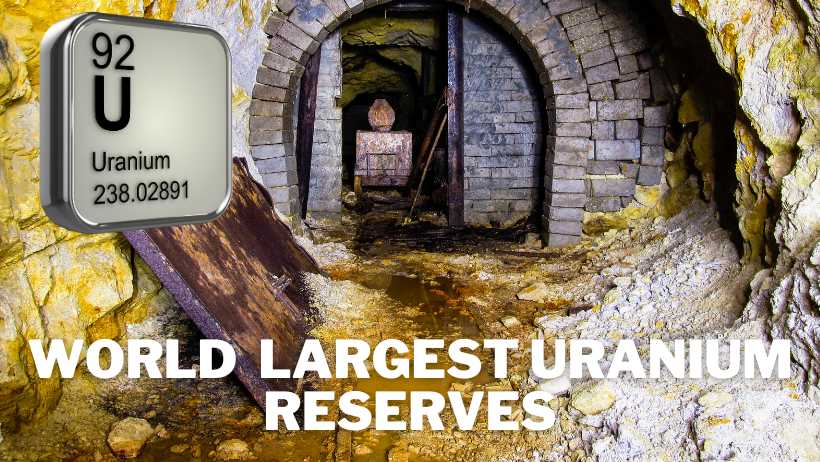Discover the astonishing abundance of uranium reserves worldwide, with Australia leading the pack. Learn about the significance of uranium reserves, their environmental impact, and the future of nuclear energy.
Immerse yourself in the incredible richness of uranium deposits as you travel through Australia, Kazakhstan, and Canada. Among these three great nations, Australia proudly holds the lion’s share, with over 1.7 million tons of this incredible resource. However, the amazement does not end there.
Prepare to be amazed as you discover the vast uranium reserves buried within the boundaries of Russia, Namibia, South Africa, Brazil, Niger, and China. With fresh finds adding to the already astounding stockpiles, it is clear that uranium is as common as tin and even more abundant than gold and silver. Join us as we explore this fascinating domain of energy potential and uncover the mysteries hidden beneath the Earth’s crust.
Australia’s Uranium reserves
Australia, famed for its wide and diverse landscapes, also plays a significant role in the world uranium market. With the world’s largest proportion of uranium deposits, Australia has established itself as a prominent leader in the business. The finding of more than 1.7 million tonnes of uranium inside its boundaries strengthens Australia’s position in the uranium market. This huge stockpile puts Australia in a strong position to supply the expanding worldwide demand for uranium.
Other Major Uranium Reserves
While Australia has the biggest proportion of the world’s uranium deposits, it is not unique in its abundance of this vital resource. Other nations have a key role in uranium production and exploration. Kazakhstan and Canada, for example, retain significant portions of the world’s uranium deposits, with Australia. These three countries account for more than half of the world’s uranium deposits. Hydrogen’s Potential to Compete with Electric Vehicles in Road Transport
However, it is worth mentioning that numerous other nations have significant uranium deposits. Russia, Namibia, South Africa, Brazil, Niger, and China all contribute to the global supply of uranium. These countries have a role in the global supply chain, ensuring a varied range of sources for this critical component.
Percentage of global uranium reserves.
The combined holdings of Australia, Kazakhstan, and Canada provide a compelling picture of their importance in the uranium sector. These three nations collectively account for more than half of the world’s uranium deposits. Their considerable stake demonstrates their global market impact and capacity to fulfill uranium demand.
Importance of Uranium Reserves
Uranium is an essential component in nuclear power generation. As countries rely more on nuclear energy to satisfy their electrical demands, ensuring a consistent supply of uranium becomes critical. Countries that rely on nuclear power would confront considerable hurdles in maintaining energy output in the absence of a sustainable uranium supply.
The relevance of uranium stockpiles goes beyond national power generation. Nuclear power is sometimes marketed as a greener alternative to fossil fuels since it does not create greenhouse gases during operation. Countries that provide a consistent supply of uranium can help to reduce carbon emissions and battle climate change.
Continued discovery of uranium deposits.
As technology progresses and exploration techniques improve, new uranium resources are identified. These finds add to the known deposits and broaden the potential sources of uranium globally. Exploration activities have grown more focused and sophisticated, enabling the discovery of previously undisclosed uranium resources.
The ongoing finding of uranium reserves is critical to supplying the increasing demand for nuclear power. As countries shift to cleaner energy sources, the need for uranium as a fuel for nuclear reactors will only grow. As a result, the continued exploration and exploitation of additional uranium deposits is critical to ensuring a stable and sustainable supply in the future.
Uranium is abundant in the Earth’s crust.
Uranium’s abundance in the Earth’s crust is truly astounding. It is more plentiful than gold and silver, making it one of the most readily available elements. In reality, uranium is approximately as abundant in the Earth’s crust as tin, an extensively used metal. This abundance highlights the promise of uranium as a dependable and accessible energy source. Breakthrough in Redox Flow Desalination shows Promise in Solving Global Water Crisis
The huge uranium deposits within the Earth’s crust hold the prospect of long-term nuclear power generation. With such availability, the dependence on uranium as a fuel source may be sustained for many years, assuring consistent energy output and reducing the danger of resource depletion.
Environmental Concerns and Regulations
While uranium mining and processing have significant advantages, they also present environmental difficulties. If not managed correctly, the extraction and refining operations might have negative consequences for the environment. These issues include the emission of radioactive waste, pollution of nearby ecosystems, and depletion of water supplies.
To counter these potential concerns, countries with large uranium deposits have enacted legislation requiring safe mining procedures. Strict environmental regulations, waste management techniques, and monitoring systems are in place to reduce the environmental effect of uranium mining operations. Countries that follow these restrictions may find a balance between reaping the advantages of uranium and conserving the environment.
Uranium’s Economic Impact
Uranium mining and exports have a considerable economic influence in nations with large uranium deposits. Uranium extraction and processing generate job opportunities and promote economic prosperity in local areas. Furthermore, uranium exports to overseas markets boost these countries’ overall economic development.
Uranium has a global economic influence. As a significant resource on the global market, uranium trading promotes international collaboration and economic interdependence. Countries having uranium reserves actively engage in commerce, assuring a consistent supply of uranium for countries that rely on nuclear power. This collaboration improves global energy security and promotes mutually beneficial collaborations.
International Cooperation and Trade
Because of the vital significance of uranium in nuclear power production, countries possessing uranium deposits understand the value of international collaboration and commerce. Collaboration ensures a steady supply of uranium for countries that rely on nuclear energy. Countries can reduce the risk of supply disruptions by diversifying their uranium sources through partnerships and agreements.
Uranium trading fosters economic progress, enhances diplomatic connections, and stimulates technical innovation. Cooperation allows countries to share experience, exchange best practices, and improve the nuclear industry’s safety and efficiency. This partnership is critical for fulfilling the increasing worldwide demand for uranium and continuing the transition to renewable energy sources. The Growing Problem of Solar Panel Waste and Its Environmental Impact
Future of Uranium Reserves
As nuclear power generation expands, demand for uranium is expected to skyrocket. Governments throughout the world are increasingly adopting nuclear energy as a response to the growing issues of climate change and energy security. The future of uranium deposits seems bright as exploratory operations aim to satisfy rising demand.
The discovery and exploitation of new uranium deposits are critical to assuring a steady supply of this vital fuel. Technological developments in exploration techniques, as well as the adoption of more sustainable mining processes, will help to increase uranium reserves. This mix of innovation and smart resource management will help to satisfy the world’s energy demands in an ecologically friendly and sustainable way.
Finally, Australia’s enormous uranium deposits, together with Kazakhstan and Canada’s considerable holdings, strengthen these nations’ positions as important participants in the global uranium market. As technology and exploration techniques evolve, the finding of new uranium deposits expands known reserves.
The quantity of uranium in the Earth’s crust, along with safe mining procedures, enables the long-term generation of nuclear energy. International collaboration and commerce help to assure a steady supply, while the future of uranium deposits looks positive as demand for nuclear power production grows.




